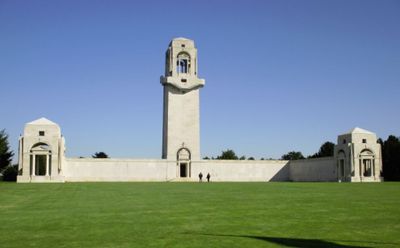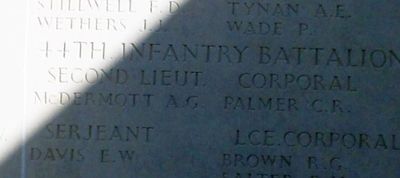Alfred George McDermott
From Our Contribution
 | |
| Personal Information | |
|---|---|
| Date of Birth | not known 1885 |
| Place of Birth | Liverpool, Lancashire, England |
| Death | 29 Sep 1918 |
| Place of Death | Quennemont Farm, St Quentin Canal, France |
| Age at Enlistment | 29 years, 3 months |
| Description |
5'6½" (1.69m) tall ; 117 lbs 53.07 kg ; fresh complexion ; brown eyes ; dark brown hair |
| Occupation | Storekeeper |
| Religion | Church of England |
| Next of Kin | Father , Mr Thomas James McDermott |
| Military Information | |
| Reg Number | 461 |
| Date of Enlistment | 1 Dec 1915 |
| Rank | 2nd Lieutenant |
| Unit/Formation | 44th Battalion, C Company / 11th Brigade, 3rd Division |
| Date of Embarkation | 6 Jun 1916 |
| Ship Embarked On | HMAT A29 Suevic |
| Fate | Killed in Action 29 Sep 1918, St Quentin Canal |
| Monument |
Jarrahdale Honour Roll Villers-Bretonneux Memorial ANZAC Memorial Park (Byford) Australian War Memorial |
| Medals |
British War Medal Victory Medal |
Contents
Pre War
Arrived in Australia in 1907 aged 18. For a time Alfred worked for his uncle's business as a grocery assistant before going pearl fishing in the Northwest. On return to the south west he worked for a time as a Superintendent in Forestry (connection to Jarrahdale) before again working in the grocery business.
Electoral Roll entries - 1910 80 King street, Boulder, grocer; 1913 Denham, Sharks Bay, pearler; 1915 James street, Guildford, storekeeper.
War Service
Soon after entry to Blackboy Hill camp, Alfred was allotted as an inaugural member of C Company, 44th Battalion which was being formed at the time. On 7 Dec 1915 he was sent to NCO School until 14 Jan 1916, and on his return to the battalion was promoted Corporal.
Alfred travelled with the battalion to England where on 6 Oct 1916 he was appointed Lance Sergeant.
On 25 Nov 1916 he proceeded overseas to France through Southampton, arriving in Le Havre, before entraining for Bailleul. From here they marched to Steenwerck before settling into reserve. On 28 Dec 1916 Alfred was promoted to Company Quarter Master Sergeant before being selected on 26 Jan 1918 to attend the No. 4 Officers Cadet Battalion at Oxford in England.
Promoted to 2nd lieutenant on 20 Aug 1918, Alfred proceeded oversees again via Southampton on 5 Sep 1918, rejoining the 44th Battalion on 10 Sep 1918. The report from his training noted that his education standard was good, his military knowledge fair, power of command and leadership skills were fair, he could ride, and in general he was very fair, nothing outstanding, but should prove useful.
On 29 Sep 1918, two American divisions were attached to Australian forces for a attack on the section of the St Quentin canal that went through a 600 metre long tunnel. The US troops were to lead the attack, followed by the two Australian divisions, with approximately 150 tanks of the 4th and 5th Tank Brigades of the British Tank Corps (including the newly trained American 301st Heavy Tank Battalion, which was equipped with British tanks) in support of the four divisions. The objective of the Americans was the Le Catelet-Nauroy Line, a defensive line east of the canal. Here the Australian 3rd Division (behind the U.S. 27th) and 5th Division (behind the U.S. 30th) were tasked to "leapfrog" through the American forces and press on towards the Beaurevoir Line. The Australian 2nd Division was in reserve.
On the left of the front (where the 44th Battalion was waiting to go into action), the 27th U.S. Division began at a disadvantage, none of its objectives were met on the first day and the Americans suffered severe losses. The 107th Infantry Regiment suffered the worst casualties sustained in a single day by any U.S. regiment during the war. Rather than leapfrogging through the Americans, the Australian 3rd Division became involved in a desperate fight for positions that should already have been captured had Monash's plan run to timetable.
A report on file from his Commanding Officer notes:
2nd Lieut. McDermott A.G., was Killed on morning of 29.9.18 at 62B A.26.A.3.7 about 150 metres south of Quennemont Farm. He was killed by a machine gun bullet through the chest, probably through the heart as he died instantly. He was in the front line of our Company leading his platoon in the advance when he was killed. He was buried about 62B A.26.A.3.7 by Padre Mills (attached to 44th Battalion).
At the end of hostilities, Alfred's grave could not be found and thus he is memorialised at Villers-Bretonneux.
Notes
Executor of Alfred's will was Carl Crosby Molyneux of Kelmscott, Western Australia

